Pesticide usage in Scotland: Outdoor Vegetable Crops 2021
This publication presents information from a survey of pesticide use on outdoor vegetable crops in Scotland during 2021.
This document is part of a collection
General trends
Crop area
In 2021 the census area of outdoor vegetable crops grown in Scotland was 22,066 hectares (Table 20). This represents an 18 per cent increase in cropped area from 2019(3) and a 14 per cent increase from 2017(4). Since the last survey, census areas of all vegetable crops have increased (Figure 1). The largest increases were seen for cauliflower (97 per cent), leeks (46 per cent), broad beans (27 per cent) and Brussels sprouts (26 per cent) (Table 20).
In 2021 peas and beans accounted for 53 per cent of the outdoor vegetable crop area, leaf brassicas 17 per cent, carrots 16 per cent, turnips & swedes seven per cent and other vegetables six per cent (Figure 2).
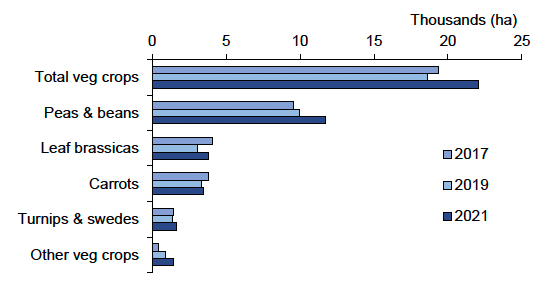
Note: areas do not include multi-cropping.
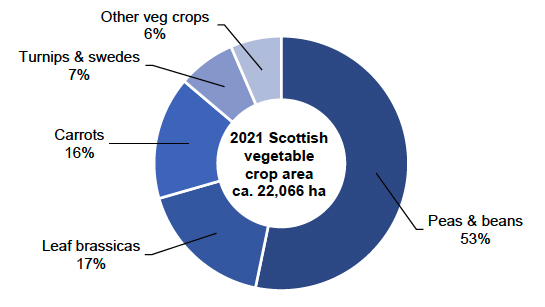
Note: areas do not include multi-cropping.
Pesticide usage
In 2021, 89 per cent of vegetable crops received a pesticide treatment, a decrease from the 2019 figure of 96 per cent and a slight decrease from the 2017 figure of 93 per cent. The crops receiving the highest overall treatments proportionally were Brussels sprouts, calabrese and vining peas (97 to 100 per cent, Table 1). Other vegetable crops, turnips & swedes, carrots and other brassica crops had the lowest proportion of treated crop (88, 77, 73 and 62 per cent treated respectively) (see Appendix 3 – definitions and notes, for the list of crops included in the 'other vegetable' and 'other brassica' crop categories). The treated area of crops received on average 5.2 applications compared to 5.3 in 2019 and 5.4 in 2017. The highest average number of applications were to Brussels sprouts with 17.4s and the lowest number were to vining peas at 2.1 applications (Table 1).
The estimated area of outdoor vegetables treated with a pesticide formulation was ca. 149,200 hectares in 2021 compared with ca. 176,200 hectares in 2019 and ca. 170,900 hectares in 2017 (Table 19, Figure 3). This represents a decrease of 15 per cent since 2019 and a decrease of 13 per cent since 2017.
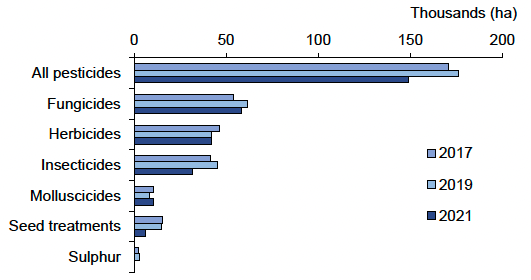
Note: physical control agents, biological control agents & growth regulators have been excluded as their use represents < 500 hectares. No sulphur was encountered in 2021.
The weight of pesticide applied was ca. 53.6 tonnes in 2021, a decrease of 26 per cent from 2019 (ca. 72.6 tonnes) and a decrease of 18 per cent from 2017 (ca. 65.6 tonnes) (Figure 4).
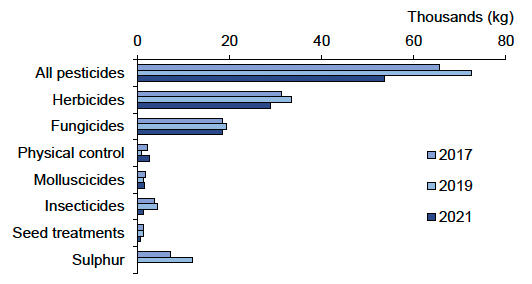
Note: growth regulators have been excluded as their use represents < 700 kg. Invertebrate biological control agents are applied by number of organisms rather than weight therefore weight data are not presented (2019 only). No sulphur was encountered in 2021.
In order to make accurate comparisons between the 2021 data and that reported in previous surveys, it is important to take into account differences in crop areas between years. Therefore, the number of treated hectares per hectare of crop grown and the total weight of pesticide used per hectare of crop grown were calculated. In 2021, for each hectare of crop grown, almost 6.8 pesticide treated hectares were recorded (Figure 5). This represents a decrease of 28 per cent when compared to 2019 and a reduction of 23 per cent from 2017. The estimated weight of pesticide applied per hectare of crop grown in 2021 was slightly below two and a half kilograms (Figure 6). This represents a decrease of 38 per cent from 2019 and a decrease of 28 per cent from 2017. This decline in overall pesticide use in 2021 may have been influenced by a number of factors such as the continuing withdrawal of active substances from the market reducing pesticide availability, and possibly driving greater use of integrated control and unfavourable climatic conditions for pests and pathogens. In 2021, there was a cold, dry, late spring on the East of Scotland where the vast majority of vegetable crops are grown (ca. 1.1 and 1.8 degrees cooler than in spring 2019 and 2017 respectively). April 2021 received 56 and 14 per cent less rainfall than in 2019 and 2017 respectively. There was also 44 and 41 per cent less rainfall in summer 2021 than in summer 2019 and 2017 respectively(5). This cold, dry, late spring, and dry summer may have helped reduce disease and weed pressure on crops in 2021.
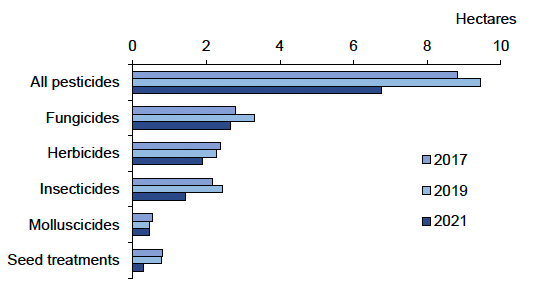
Note: growth regulators, physical control & sulphur have been excluded as their use represents < 0.1 treated hectares per hectare of crop grown.
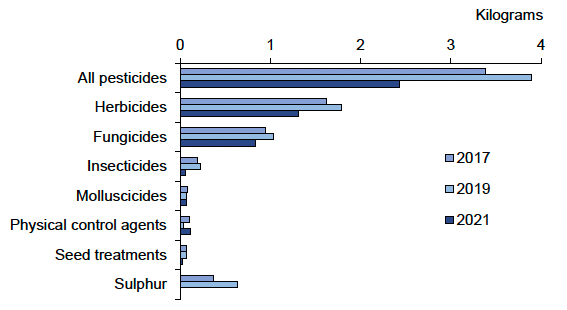
Note: growth regulators have been excluded as their use represents < 0.1 kg per hectare of crop grown.
As in 2019 & 2017, fungicides were the most frequently used pesticides by area treated, on outdoor vegetable crops (Figure 7). They were followed by herbicides and insecticides. Fungicides accounted for 40 per cent of total pesticide treated area and 35 per cent of the total weight of pesticides applied (Figures 7 & 8). When changes in crop area are taken into account, the area treated with fungicides decreased 20 per cent from 2019 to 2021 and decreased five per cent between 2017 and 2021 (Figure 5). From 2019 to 2021, there was a decrease of 19 per cent in the weight of fungicides used per hectare of crop grown, and a decrease of 12 per cent between 2017 and 2021 (Figure 6). The decreased use of fungicides in 2021 compared to the previous two surveys may have been influenced by a number of factors such as the weather and loss of active substances from the market. The cold, dry, spring and dry summer may have helped to reduce disease pressure on crops in 2021(5)and thus the need to apply fungicide sprays. In addition, since the previous survey, the fungicides fenpropimorph and chlorothalonil applied to 2,953 ha and 1,061 ha respectively in 2019 have been withdrawn from the market and were not available during the 2021 season. The principal fungicide mode of action on vegetable crops continues to be inhibition of respiration (this group includes strobilurins and SDHIs, Table 15). The use of fungicides with this mode of action increased 11 per cent in terms of treated area when compared to the previous survey in 2019.
In 2021, herbicides accounted for 28 per cent of the total pesticide treated area and 54 per cent of the total weight of pesticides applied (Figures 7 & 8). When changes in crop area are taken into account, there was a decrease in area treated with herbicide formulations of 16 per cent from 2019 to 2021 and 21 per cent from 2017 and 2021 (Figure 5). In terms of weight of pesticide applied, when area of crop grown is taken into account, there was a decrease of 27 per cent from 2019 to 2021 and 19 per cent from 2017 to 2021 (Figure 6). The continuation of the bentazone stewardship campaign designed to promote responsible product use and sustainable on-farm water stewardship may have influenced the decline in the use of this active substance(6). The area treated with bentazone, primarily applied to peas and beans, decreased by 26 per cent in 2021 compared with 2017 despite an increase in the area of crop grown (Table 17). When corrected for area of crop grown, the glyphosate treated area decreased by 25 per cent and the weight applied decreased by 19 per cent from 2019 to 2021. Glyphosate is applied both as an inter-row herbicide and as a before planting treatment to create stale seed beds. The cold, dry spring in 2021 reduced weed emergence before planting and resulted in less requirement for before planting treatments.
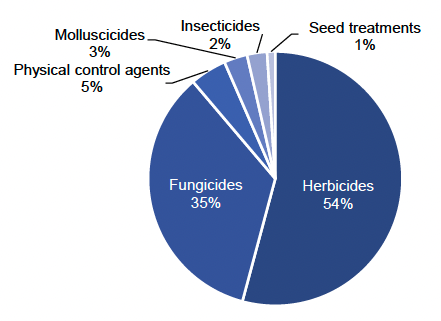
Note: growth regulators and physical control have been excluded as their use represents < 0.5 per cent treated area.
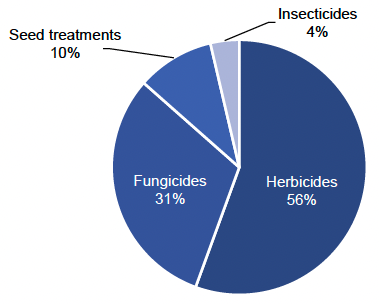
Note: growth regulators have been excluded as their use represents < 0.5 per cent quantity applied.
Insecticides accounted for 21 per cent of the total pesticide treated area and two per cent of the total weight of pesticides applied (Figures 7 & 8). There was a 41 per cent decrease from 2019 to 2021 and a 34 per cent decrease from 2017 to 2021 in the area treated with insecticide formulations when changes in crop area are taken into account (Figure 5). Similarly, in terms of weight applied per hectare of crop grown, there was a decrease of 73 per cent from 2019 to 2021 and 67 per cent from 2017 to 2021 (Figure 6). Pyrethroids remain the principal form of insect control employed, in terms of area treated (Table 14). Several key insecticide active substances from other chemical groups have been withdrawn since the previous survey including oxamyl, pymetrozine and thiacloprid. With few chemical alternatives, growers are increasingly reliant on the use of pyrethroids. Several insect pests have known resistance to pyrethroids and growers are increasingly taking a more integrated approach to control pests. In addition, the cold, dry, late spring may have helped reduce pest pressure in 2021 and thus the need to apply insecticides.
Eighty-six per cent of leaf brassica crops and nine per cent of other vegetables were grown from transplants. The rest of the crops were grown directly from seed. Of these crops, other vegetables had the highest proportion of treated seed (78 per cent) followed by carrots (45 per cent) then vining peas (23 per cent). Seed treatments accounted for four per cent of the total area treated and one per cent of the total weight applied (Figure 7 & 8). When changes in crop area are taken into account, there was a decrease in area treated with seed treatments of 64 per cent from both 2019 to 2021 and 2017 to 2021 (Figure 5). The weight of seed treatment applied per hectare of crop grown decreased by 62 per cent from 2019 to 2021 and by 63 per cent from 2017 to 2021 (Figure 6). This large decrease in the use of seed treatments is the result of the withdrawal of a number of key products. Wakil XL containing cymoxanil, fludioxonil and metalaxyl-M was withdrawn in June 2021. This was a primary seed treatment of vining peas, broad beans, carrots and parsnips applied to 10,329 ha in 2019 compared with only 5,574 ha in 2021. The use of seed treatments on vining peas decreased from 100 per cent treatment in 2019 to only 23 per cent in 2021 (Table 2). The 2021 season was also the final season for the use of Force ST containing tefluthrin prior to its withdrawal for use on vegetable crops in December 2021. Tefluthrin applied to carrot seed was applied to 1,357 ha in 2019 compared with only 732 ha in 2021. In addition, thiram which had been applied to 3,100 ha in 2019 (applied to peas, beans and turnips and swede) was unavailable during 2021 following its withdrawal in January 2020.
Molluscicides accounted for seven per cent of the total pesticide treated area and three per cent of weight (Figures 7 & 8). When changes in crop area are taken into account, there was no change between 2019 and 2021 and a decrease of 14 per cent between 2017 and 2021 (Figure 5). Similarly, the weight of molluscicides applied per hectare of crop grown was very similar in 2021 compared to 2019 and decreased 16 per cent compared to 2017. Slug numbers are closely linked to weather conditions and fluctuate accordingly. There were increased levels of slug activity in 2017 due to the wet summer, whereas in 2019 and 2021 the cold, late spring decreased the risk of slug damage(5).
Sulphur has dual use as both a fertiliser and a fungicidal treatment and is permissible in some organic systems. In 2021, there was no use of sulphur encountered in the survey. In 2019, an estimated 3,110 ha was treated with sulphur. The reduction in use in 2021 may have been influenced by supply issues and price increases.
Pesticides classified as physical control represented less than 0.5 per cent of the total pesticide treated area and five per cent of the total weight of pesticides applied (Figure 7 & 8). In 2021, as in 2019, all physical control encountered was garlic based. This pesticide type was only applied to carrots (13 per cent of crop grown, Table 10) likely as a control for free living nematodes. When changes in crop area are taken into account, there was an increase in area treated with physical control by 194 per cent from 2019 to 2021 (weight applied increased by 168 per cent).
Growth regulators accounted for less than 0.5 per cent of the treated area and weight applied in 2021. Maleic hydrazide was the only growth regulator encountered in the 2021 survey and has seen a 62 per cent decrease in use from 2019 to 2021.
As well as changes in overall trends in application of pesticide groups since the previous survey, there has been variation in the use of individual active substances. The herbicide bromoxynil, the insecticide/nematicide fluopyram and fungicides fluxapyroxad, oxathiapiprolin and benthiavalicarb were recorded for the first time on outdoor vegetable crops in this survey (Table 13). It should be noted that fluopyram is classed as a broad-spectrum fungicide but also has nematicide activity and was only used as a nematicide on vegetable crops in 2021. This may be as an alternative to the nematicide oxamyl which was withdrawn in December 2020. In terms of area treated, the most used active substances were the fungicides boscalid and pyraclostrobin, which both increased by 50 per cent since 2019 (Table 17). Other notable changes include an increase (1,382 per cent) in the area treated with the fungicides fluopicolide and propamocarb hydrochloride. The use of the insecticide cyantraniliprole increased by 817 per cent in terms of both area treated and weight applied, while the area treated with the herbicide clopyralid increased by 257 percent and 366 per cent by weight applied (Table 18).
There was a continued increase in use of the molluscicide ferric phosphate, repeating the trend seen in the previous two reports. Use of ferric phosphate increased by 28 per cent (area treated) and 32 per cent (weight applied) (Tables 17 & 18). The use of metaldehyde in 2021 was similar to 2019, with an increase of two per cent of area treated and a decrease of two per cent of weight applied. This was the final season growers could use metaldehyde prior to its withdrawal in March 2022(7).
Contact
Email: psu@sasa.gov.scot
There is a problem
Thanks for your feedback